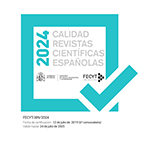Tipología de la transición: el paradigma español
Abstract
In this article I refer to the political transitions of our time, specifically to those that occurred after the second postwar period. Upon his multifaceted history I will try to draw a typology in the sense that Weber’s ideal types gave and for that, I will attend to legal and institutional aspect of the transition itself. Three types of transitions occurred in the last half century: first, the transition from empire to nation-state, second, the transition from centrally planned economies to market economies, and third, the transition from an authoritarian to a democratic system. The latter type of Transition is the one that I deal with and, crucially, of the Spanish political transition, which has gone from an authoritarian state to democracy. Here this transition is regarded as a model worthy of study and imitation and, despite criticism that it is subject from very different political places, the reality is that it was crowned with success and has led to the longest period of political stability democratic and economic and social progress to the Spanish. Thus their study, in the light of the typology outlined, can serve to validate the typological analysis.Downloads
Article download
License
In order to support the global exchange of knowledge, the journal Res Publica. Revista de Historia de las Ideas Políticas is allowing unrestricted access to its content as from its publication in this electronic edition, and as such it is an open-access journal. The originals published in this journal are the property of the Complutense University of Madrid and any reproduction thereof in full or in part must cite the source. All content is distributed under a Creative Commons Attribution 4.0 use and distribution licence (CC BY 4.0). This circumstance must be expressly stated in these terms where necessary. You can view the summary and the complete legal text of the licence.









